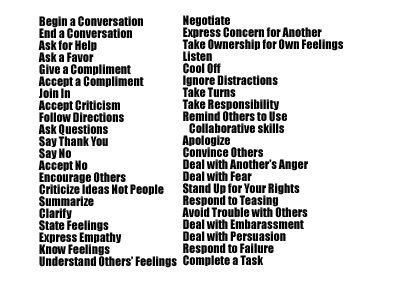

|
Class norms represent the behavior expectations that support the core concepts of trust, sharing, belonging and respect. Collaborative skills are the specific ways in which students are expected to behave in order to achieve class norms. After norms have been developed, collaborative skills are assessed, prioritized and taught. Collaborative skills that we have identified as promoting the core concepts and supporting class norms are listed below. This list of collaborative skills has been used successfully by instructional teams to identify skills that address the ways students and teachers should interact to realize class norms. The list is not exhaustive and some classrooms may have to add skills to fully meet their needs.
Students can be involved in identifying and prioritizing collaborative skills by, for example, discussing and listing behaviors which support the norms, or byworking jointly with the teacher to select skills from the list.Selecting a collaborative skill to teach is really just a matter of choosing a place to begin. The class norms that students have not already mastered, as well as the collaborative skills that support them, must eventually be taught and incorporated into students’ repertoire of skills. The instructional team should set aside a 20-30 minute block of instructional time each week for initial instruction on collaborative skills. The goal is to introduce one new skill each week. The team should also identify one or more daily interactive activities (partner activities, small group activities) during which the students can practice using the collaborative skill. The activity can be from any curriculum area (e.g., science, math, art, music, reading) as long as it provides students opportunities to practice the collaborative skill. Following each interactive activity, an additional 5 minutes is needed for the students to process how well they used the skill during the activity and to set goals for improvement, if needed. Defining and describing what collaborative skills look and sound like make the skills concrete and “real” to students. The description provides a specific guide of how students are to behave and defines how the model behavior should look and sound. A T-Chart is a graphic organizer, which can be employed to describe what a collaborative skill “looks like” and “sounds like.” Click here to see a sample T-Chart.
|
